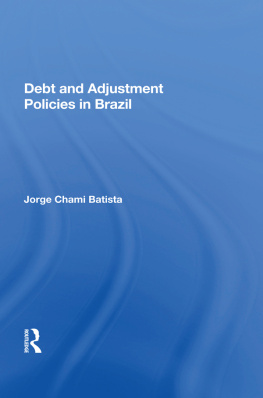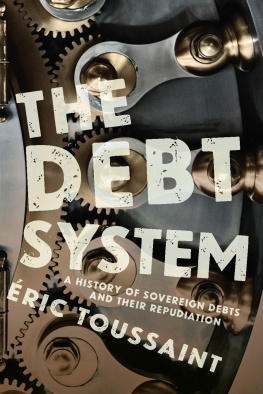Debt and Adjustment Policies in Brazil
First published 1992 by Westview Press
Published 2018 by Routledge
52 Vanderbilt Avenue, New York, NY 10017
2 Park Square, Milton Park, Abingdon, Oxon OX14 4RN
Routledge is an imprint of the Taylor & Francis Group, an informa business
Copyright 1992 by Taylor & Francis
All rights reserved. No part of this book may be reprinted or reproduced or utilised in any form or by any electronic, mechanical, or other means, now known or hereafter invented, including photocopying and recording, or in any information storage or retrieval system, without permission in writing from the publishers.
Notice:
Product or corporate names may be trademarks or registered trademarks, and are used only for identification and explanation without intent to infringe.
Library of Congress Cataloging-in-Publication Data
Batista, Jorge Chami, 1954
Debt and adjustment policies in Brazil / by Jorge
Chami Batista.
p.cm.
Includes bibliographical references and index.
ISBN 0-8133-8360-9
1. Debts, ExternalBrazil. 2. Structural
adjustment (Economic policy)Brazil. 3. Brazil
Economic policy. I. Title.
HJ8579.B34 1992
336. 340981dc20
92-481
CIP
ISBN 13: 978-0-367-01656-2 (hbk)
To Linda, Solange, and Luiza
Tables
Appendix Tables
Figures
This book is the result of long research, which started in early 1983 and aimed at examining Brazils economic adjustment following the two oil shocks of 1973 and 1979. Most of the information and data used in this book was gathered in the period between 1983 and 1987. Therefore, the detailed analysis that this book contains on the economic policies and structural changes implemented in Brazil refers basically to the period between the first oil shock in 1973 and the collapse of the Cruzado Plan early in 1987.
In the past five years (1986/1991), we have witnessed a sharp deterioration in the Brazilian economy. Gross domestic product has been falling dramatically and the economy has several times been on the edge of hyperinflation. This deterioration can be largely ascribed to bad management of the economy. Since the Cruzado Plan in 1986, five attempts have been made to control the rate of inflation through freezing prices. All these attempts have failed to stabilize the economy. However, very often, needed economic reforms, especially fiscal reforms, have been constrained by political factors. Therefore, it should come as no surprise that Brazil has had five finance ministers in the six years between 1986 and 1991.
Although Brazils current economic problems are strongly correlated with the economic measures implemented in the second half of the 1980s and early 1990s, the root causes of these problems are to be found in the changes that took place in Brazil and in the international environment confronting the Brazilian economy in the 1970s and first half of the 1980s.
As many of my research sources were available only in Portuguese, I have opted to translate some of the extracts used in this book from the original Portuguese to English.
I should like to thank Dr. John R. Wells, who has been a major source of inspiration for this piece of work, and Dr. Winston Fritsch, who has consistently given me help and advice over a number of years. Dr. Marcelo Abreu, Dr. Ricardo Bielschowsky, Dr. Michael Landesmann, Dr. John Goodman, Dr. Manuel Alcino, Dr. Edmar Bacha, and Mr. Andr Spitz have read draft chapters and given me many useful comments.
I have also benefited from numerous discussions with my students and from talks with Professor Luiz Carlos Bresser Pereira, Dr. Femo Bracher, Professor Antonio Barros de Castro, Mr. Jos Cechin, and Dr. Ricardo Santiago.
I would also like to express my deepest gratitude to my friends Roberto Batista, Marcelo Auler, Maria Alice da Costa, Samuel Herd, and Merridy Pitcher for their help and continued support over a long period.
Solange Vereza has shared every step in this journey and I find no words to thank her for it all.
Jorge Chami Batista
1
Introduction
In the period between 1974, after the first oil shock, and 1981, before the so-called debt crisis, Brazil was amongst the largest net recipients of real resources in the developing world. Indeed, it was basically owing to the large scale absorption of real resources from the rest of the world that the economy of Brazil, despite the adverse real income effects of the two oil shocks, was able to maintain its rapid industrialization process until the end of the 1970s.
However, in the late 1970s and early 1980s, the Brazilian economy was confronted with a truly dramatic deterioration in the international economic environment. Brazils external terms of trade collapsed, whilst international real rates of interest were raised to absolutely unprecedented levels, following the adoption of very restrictive monetary policies in the advanced economies. This deterioration in the international economic environment substantially contributed to Brazils growing demand for external finance and accelerating inflationary process.
In 1982, following the Mexico moratorium, panic spread through the international banking system, virtually interrupting lending to developing countries. Unable to obtain adequate new capital inflow to cover all interest payments on its foreign debt, the Brazilian economy was prematurely forced to start making large transfers of real resources to the rest of the world. As a result, income per capita in Brazil suffered a major set back in the 1981/83 period. Although there was some recovery in income per capita in 1984/86, the growth performance of Brazils income per capita in the 1980s was generally poor. Given that the economy has also been marked by very low rates of investment, the rate of growth of potential output has been very unsatisfactory.
In the light of these events, an intense debate has emerged in the literature concerning the adequacy of the growth-cum-debt strategy, adopted in Brazil, under the guidelines of the Second National Development Plan (1974), as a response to the first oil shock.
The industrial strategy and the macroeconomic adjustment policies adopted in Brazil after the first oil shock have been criticized on a number of grounds and with varying degrees of intensity by a number of economists. On the other hand, others have strongly backed the strategy and policies implemented in the period.
Some critics would generally have preferred the adoption of an orthodox adjustment programme, based on restrictive demand policies and an aggressive exchange rate policy, rather than the growth-cum-debt strategy adopted in Brazil.
Along these lines, Roberto Campos has pointed out that:
In 1974, after the first oil shock, and then in 1980, after the second oil shock, we entertained the illusion that we could be an Island of Prosperity in a sea of recession. From this mirage the Second National Development Plan was born. While other countries were making a painful adjustment, we preferred to resort to financing. Financing rather than adjustment , that was our motto. Having been postponed, the adjustment now has to be bitter. The black September of 1982 marked the end of the financing era and the beginning of the adjustment era.
Later he added:
We have made timid and inadequate adjustment to the first oil crisis, with too ambitious programmes in some sectors (nuclear energy, steel, etc) and without the support of domestic savings while the morbid presence of the state grewthe refusal to adjust which was made possible by the easy access to the eurodollar market is at the roots of the collapse of our dream of becoming a large power.









